This work was supported by Cooperative Agreement #NU58DP007539-01 from the Centers for Disease Control and Prevention (CDC).
Resources
“Cancer Screening Prevalence and Associated Factors Among US Adults” is a special collection of 11 articles that look at cancer screening trends, what influences cancer screening participation, and public health practices that help increase screening in specific populations.
Nuestras Voces (Our Voices) Network developed infographics based on key findings and the factors that influence youth tobacco product use among U.S. middle school (grades 6–8) and high school (grades 9–12) students.
This two-page summary features an easy-to-read table that shows Community Preventive Services Task Force (CPSTF) recommendations and findings for evaluated intervention approaches.
HDPulse is designed to provide access to data and interventions related to minority health and health disparities.
The National Hispanic Council on Aging (NHCOA) and National Minority Quality Forum (NMQF) released results from a recent joint poll conducted by Morning Consult, focusing on the importance of health equity in addressing barriers to care.
Bridging Healthy People 2020 and Healthy People 2030 launched ODPHP's new Healthy People 2030 Webinar Series with a presentation on Healthy People 2020 achievements and the transition to Healthy People 2030.
This Guide for Program Development and the accompanying Program Development Workbook were developed to efficiently and effectively walk you through the process of survivorship and navigation program planning.
This health awareness campaign is designed to help partners implement evidence-based practices when communicating about cancer survivorship, including National Cancer Survivors Day® on the first Sunday of June. It can also help you plan, implement and evaluate your social media strategy and…
Hosting effective online community events and meetings in rural, remote, and Indigenous Communities can be challenging. From tools and technology to logistics and engagement, this toolkit was created to help you address some of the most common virtual meeting barriers and opportunities.
Crowdsourced from more than 600 public health communicators across 51 states and territories, this resource highlights the immense impact of public health communicators during the pandemic and offers a powerful wealth of insights for protecting public health through COVID-19 and beyond.

